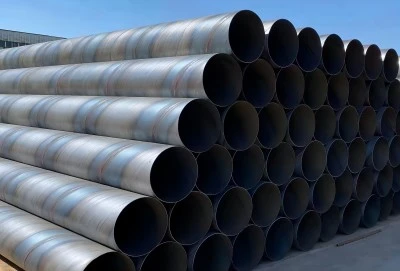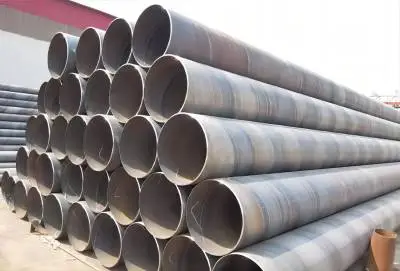In the world of steel pipe manufacturing, two prominent methods stand out: ERW (Electric Resistance Welded) and spiral welded pipe production. While both techniques result in high-quality pipes used across various industries, they differ significantly in their production processes, characteristics, and applications.
|
|
|
Basic production process of ERW and spiral welded pipes
ERW pipes and spiral welded pipes, while both classified as welded steel pipes, undergo distinct manufacturing processes that contribute to their unique properties and applications.
ERW Pipe Production:
The ERW pipe manufacturing process begins with a flat steel strip or coil. This material is carefully fed through a series of rollers that gradually form it into a cylindrical shape. As the edges of the strip come together, they are welded using high-frequency electrical resistance welding. This method creates a strong, continuous weld along the length of the pipe without the need for additional filler material.
Key steps in ERW pipe production include:
- Coil preparation and edge milling
- Forming the strip into a circular shape
- High-frequency welding of the seam
- Weld bead removal (if required)
- Heat treatment for stress relief
- Sizing and straightening
- Non-destructive testing and quality control
Spiral Welded Pipe Production:
Spiral welded pipes, also known as spirally welded pipes or helical welded pipes, are manufactured using a different approach. The process starts with a wide steel coil that is fed into a spiral pipe forming machine at an angle. As the coil moves through the machine, it is continuously formed into a helical shape, creating a spiral seam that runs along the entire length of the pipe.
The production process for spiral welded pipes typically involves:
- Coil preparation and edge beveling
- Spiral forming of the steel strip
- Continuous welding of the helical seam (often using submerged arc welding)
- Internal and external weld reinforcement
- Heat treatment for stress relief
- Hydrostatic testing and dimensional checks
- Non-destructive testing and quality control
The spiral welding process allows for the production of pipes with larger diameters and longer lengths compared to ERW pipes, making them suitable for applications such as large-scale water transmission, oil and gas pipelines, and piling projects.
Strength and pressure performance comparison
When comparing ERW pipes and spiral welded pipes, it's essential to consider their strength and pressure performance characteristics, as these factors significantly influence their suitability for different applications.
ERW Pipe Strength and Pressure Performance:
ERW pipes are known for their high strength-to-weight ratio and excellent pressure-bearing capabilities. The continuous longitudinal weld seam contributes to their overall structural integrity. Some key points regarding ERW pipe strength and pressure performance include:
- Uniform wall thickness: ERW pipes typically have a consistent wall thickness along their entire length, which helps distribute stress evenly.
- High tensile strength: The electrical resistance welding process creates a strong bond, resulting in pipes with good tensile strength.
- Excellent pressure resistance: ERW pipes can withstand high internal pressures, making them suitable for various fluid transmission applications.
- Good fatigue resistance: The uniform structure of ERW pipes contributes to their ability to withstand cyclic loading.
Spiral Welded Pipe Strength and Pressure Performance:
Spiral welded pipes offer unique strength characteristics due to their helical seam construction. Some notable aspects of their strength and pressure performance include:
- Enhanced hoop strength: The spiral weld configuration provides increased resistance to hoop stress, which is particularly beneficial for large-diameter pipes.
- Flexibility in wall thickness: Spiral welded pipes can be manufactured with varying wall thicknesses along their length, allowing for optimized material usage and weight distribution.
- Good pressure-bearing capacity: While generally comparable to ERW pipes, spiral welded pipes may have slightly lower pressure ratings for the same wall thickness due to the helical seam configuration.
- Excellent resistance to external loads: The spiral structure provides good resistance to bending and external pressures, making these pipes suitable for underground and underwater applications.
It's important to note that the actual strength and pressure performance of both ERW and spiral pipes can vary depending on factors such as material grade, wall thickness, and manufacturing quality. In many cases, the choice between ERW and spiral pipes for a specific application depends on factors beyond just strength and pressure performance, including diameter requirements, length needs, and installation considerations.
Dimensional tolerances and quality control differences
Ensuring consistent quality and adherence to dimensional tolerances is crucial in pipe manufacturing. Both ERW and spiral welded pipe production processes have their own set of quality control measures and dimensional considerations.
ERW Pipe Dimensional Tolerances and Quality Control:
ERW pipes are known for their tight dimensional tolerances and consistent wall thickness. Quality control measures for ERW pipes typically include:
- Diameter and ovality control: ERW pipes generally have tighter tolerances for outside diameter and roundness compared to spiral welded pipes.
- Wall thickness consistency: The ERW process allows for precise control of wall thickness along the entire length of the pipe.
- Straightness: ERW pipes tend to have better straightness due to the linear nature of their production process.
- Weld seam quality: High-frequency welding enables consistent weld quality, which is often verified through non-destructive testing methods such as ultrasonic testing or eddy current inspection.
- Surface finish: ERW pipes typically have a smoother surface finish, which can be beneficial for certain applications and coating processes.
Spiral Pipe Dimensional Tolerances and Quality Control:
Spiral welded pipes, while offering advantages in terms of size range and production flexibility, may have slightly different quality control considerations:
- Diameter tolerance: Due to the helical forming process, spiral welded pipes may have slightly wider diameter tolerances compared to ERW pipes, especially for larger diameters.
- Wall thickness variation: The spiral welding process allows for the production of pipes with varying wall thicknesses along their length, which can be both an advantage and a challenge in terms of quality control.
- Weld seam inspection: The helical weld seam requires specialized inspection techniques to ensure integrity along its entire length. This often involves advanced ultrasonic testing methods.
- Roundness and straightness: While generally good, the spiral forming process may result in slightly less precise roundness and straightness compared to ERW pipes, particularly for very large diameters.
- End finishing: Special attention is often given to the pipe ends to ensure they meet required perpendicularity and roundness for proper joining in the field.
Both ERW and spiral welded pipe manufacturers employ rigorous quality control measures to ensure their products meet industry standards and customer specifications. These may include:
- Material verification and traceability
- In-process dimensional checks
- Non-destructive testing (NDT) of weld seams
- Hydrostatic pressure testing
- Mechanical property testing (e.g., tensile strength, yield strength)
- Visual inspection for surface defects
- Coating and lining quality checks (if applicable)
It's worth noting that while there are general differences in dimensional tolerances and quality control between ERW and spiral welded pipes, advancements in manufacturing technology have narrowed these gaps. High-quality spiral pipes can often meet or exceed the dimensional and quality requirements traditionally associated with ERW pipes, particularly for large-diameter applications.
For those seeking high-quality ERW or LSAW (Longitudinal Submerged Arc Welded) steel pipes, Longma Group stands out as a leading manufacturer in China. With a specialization in producing large-diameter, thick-walled, double-sided submerged arc welded steel pipes, Longma Group has been at the forefront of the industry since 2003. Their commitment to quality and innovation is evident in their impressive annual output, which exceeded 1,000,000 tons by the end of 2023. Whether your project requires ERW pipes or other specialized steel pipe solutions, Longma Group has the expertise and capacity to meet your needs. For more information or to discuss your specific requirements, please don't hesitate to contact Longma Group at info@longma-group.com.














